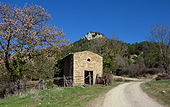Borredà
| Borredà municipality | ||
|---|---|---|
 Borredà - Town Hall Square
|
||
| coat of arms | Map of Spain | |

|
|
|
| Basic data | ||
| Autonomous Community : |
|
|
| Province : | Barcelona | |
| Comarca : | Berguedà | |
| Coordinates | 42 ° 8 ′ N , 2 ° 0 ′ E | |
| Height : | 854 msnm | |
| Area : | 43.56 km² | |
| Residents : | 445 (Jan. 1, 2019) | |
| Population density : | 10.22 inh / km² | |
| Postal code : | 08619 | |
| Municipality number ( INE ): | 08024 | |
| administration | ||
| Website : | www.borreda.net/inici.php | |
Borredà (Spanish Borredá ) is a place and a municipality ( municipi ) with 445 inhabitants (as of January 1, 2019) in the Comarca Berguedà in the province of Barcelona in the autonomous region of Catalonia .
location
The place Borredà is located at an altitude of about 850 meters in the southern foothills of the Pyrenees in the Comarca Berguedà in northern Catalonia. The city of Manresa is about 68 kilometers (driving distance) south; Berga , the main town of the comarca, is about 20 kilometers to the southwest.
Population development
| year | 1960 | 1970 | 1981 | 1991 | 2001 | 2011 |
| Residents | 761 | 597 | 488 | 446 | 499 | 584 |
In the second half of the 19th century, the number of inhabitants of the municipality was at times over 1,000. Since then, due to the increasing mechanization of agriculture and the gradual closure of smaller textile factories, a continuous decline in the population has been recorded.
economy
In the past, the inhabitants lived mainly as self-sufficient farmers from agriculture, which also included growing wine and keeping cattle (especially cattle, pigs, sheep and goats). As early as the end of the Middle Ages, Bagà also functioned as a craft and mercantile center for the villages and individual farms ( masies ) in the area. Several small textile manufacturers have been based in the municipality since the 18th century, but they have gradually ceased production since the 1960s. Instead, tourism plays a not insignificant role for the income of the population in the form of renting out holiday homes ( cases rurals ).
history
From prehistoric, Iberian , Roman - ancient , Visigothic and Islamic times , no traces of settlement have been found. From a recapture ( reconquista ) of the region hardly possible to speak, as it was nearly deserted. In the Middle Ages, the church and place were under the manorial rule ( senyorio ) of the Santa Maria de Ripoll monastery for a long time .
Attractions
- The parish church of Santa Maria already had a previous building in the 9th century, but it was demolished when the church was rebuilt in the 11th century. Parts of the Romanesque church still exist, but the building was expanded to three naves in the 18th century; Furthermore, the portal surround and the bell tower ( campanar ) date from this period.
- The small chapel of La Mercè dates from the 18th century; however, it is in a ruinous state.
- The Romanesque church of Sant Sadurní was formerly part of the long-abandoned town of Rotgers . The exterior of the simple structure is completely unadorned, with the exception of the apse , which is structured with pilaster strips and a final round arch frieze . The two-storey bell tower was added later and shows biforic windows (also ajimez ) with small central pillars in the upper part .
- The village of Salselles has also disappeared. The ruins of the church, which was largely rebuilt in the baroque era, are still standing.
- The Romanesque chapel of Sant Esteve de Comià has a two-part bell gable ( espadanya ).
- The Romanesque chapel of Sant Martí de Boatelle also only remains in ruins.
Web links
Individual evidence
- ↑ Cifras oficiales de población resultantes de la revisión del Padrón municipal a 1 de enero . Population statistics from the Instituto Nacional de Estadística (population update).


